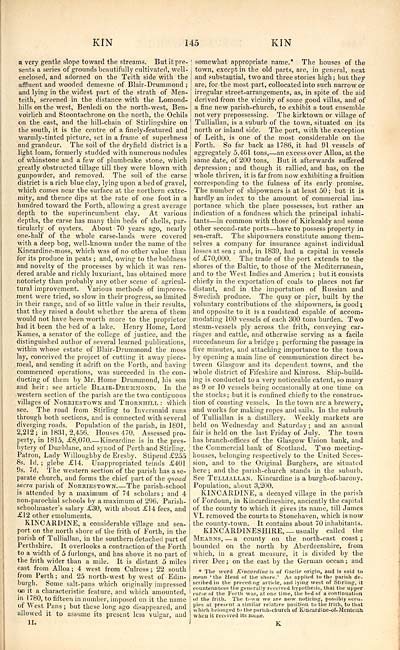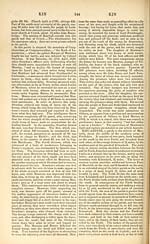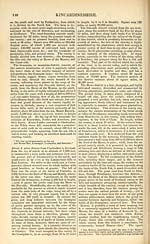Topographical, statistical, and historical gazetteer of Scotland > Volume 2
(157) Page 145
Download files
Complete book:
Individual page:
Thumbnail gallery: Grid view | List view

KIN
145
KIN
n very gentle slope toward the streams. But it pre-
sents a series of grounds beautifully cultivated, well-
enclosed, and adorned on the Teith side with the
affluent and wooded demesne of Blair-Drummond ;
and lying in the widest part of the strath of Men-
teith, screened in the distance with the Lomond-
hills on the west, Benledi on the north-west, Ben-
voirlich and Stoontachrone on the north, the Ochils
on the east, and the hill-chain of Stirlingshire on
the south, it is the centre of a finely-featured and
warmly-tinted picture, set in a frame of superbness
and grandeur. The soil of the dryfield district is a
light loam, formerly studded with numerous nodules
of whinstone and a few of plumbcake stone, which
greatly obstructed tillage till they were blown with
gunpowder, and removed. The soil of the carse
district is a rich blue clay, lying upon a bed of gravel,
which comes near the surface at the northern extre-
mity, and thence dips at the rate of one foot in a
hundred toward the Forth, allowing a great average
depth to the superincumbent clay. At various
depths, the carse has many thin beds of shells, par-
ticularly of oysters. About 70 years ago, nearly
one-half of the whole carse-lands were covered
with a deep bog, well-known under the name of the
Kincardine-moss, which was of no other value than
for its produce in peats ; and, owing to the boldness
and novelty of the processes by which it was ren-
dered arable and richly luxuriant, has obtained more
notoriety than probably any other scene of agricul-
tural improvement. Various methods of improve-
ment were tried, so slow in their progress, so limited
in their range, and of so little value in their results,
that they raised a doubt whether the arena of them
would not have been worth more to the proprietor
had it been the bed of a lake. Henry Home, Lord
Kames, a senator of the college of justice, and the
distinguished author of several learned publications,
within whose estate of Blair-Drummond the moss
lay, conceived the project of cutting it away piece-
meal, and sending it adrift on the Forth, and having
commenced operations, was succeeded in the con-
ducting of them by Mr. Home Drummond, his son
and heir : see article Blair-Drummond. In the
western section of the parish are the two contiguous
villages of Norriestown and Thornhill : which
see. The road from Stirling to Inversnaid runs
through both sections, and is connected with several
diverging roads. Population of the parish, in 1801,
2,212 ; in 1831, 2,456. Houses 470. Assessed pro-
perty, in 1815, £8,070.. — Kincardine is in the pres-
bytery of Dunblane, and synod of Perth and Stirling.
Patron, Lady Willoughby de Eresby. Stipend £255
8s. Id. ; glebe £14. Unappropriated teinds £401
9s. 7d. The western section of the parish has a se-
parate church, and forms the chief part of the quoad
sacra parish of Norriestown The parish-school
is attended by a maximum of 74 scholars ; and 4
non-parochial schools by a maximum of 296. Parish-
schoolmaster's salary £30, with about £14 fees, and
£12 other emoluments.
KINCARDINE, a considerable village and sea-
port on the north shore of the frith of Forth, in the
parish of Tulliallan, in the southern detached part of
Perthshire. It overlooks a contraction of the Forth
to a width of 5 furlongs, and has above it no part of
the frith wider than a mile. It is distant 5 miles
east from Alloa ; 4 west from Culross ; 22 south
from Perth ; and 25 north-west by west of Edin-
burgh. Some salt-pans which originally impressed
on it a characteristic feature, and which amounted,
in 1780, to fifteen in number, imposed on it the name
of "West Pans ; but these long ago disappeared, and
allowed it to assume its present less vulgar, and
II.
somewhat appropriate name.* The houses of the
town, except in the old parts, are, in general, neat
and substantial, two and three stories high ; but they
are, for the most part, collocated into such narrow or
irregular street-arrangements, as, in spite of the aid
derived from the vicinity of some good villas, and of
a fine new parish-church, to exhibit a. tout ensemble
not very prepossessing. The kirktown or village of
Tulliallan, is a suburb of the town, situated on its
north or inland side. The port, with the exception
of Leith, is one of the most considerable on the
Forth. So far back as 1786, it had 91 vessels of
aggregately 5,461 tons, — an excess over Alloa, at the
same date, of 200 tons. But it afterwards suffered
depression ; and though it rallied, and has, on the
whole thriven, it is far from now exhibiting a fruition
corresponding to the fulness of its early promise.
The number of shipowners is at least 50; but it is
hardly an index to the amount of commercial im-
portance which the place possesses, but rather an
indication of a fondness which the principal inhabi-
tants — in common with those of Kirkcaldy and some
other second-rate ports — have to possess property in
sea-craft. The shipowners constitute among them-
selves a company for insurance against individual
losses at sea ; and, in 1839, had a capital in vessels
of £70,000. The trade of the port extends to the
shores of the Baltic, to those of the Mediterranean,
and to the AVest Indies and America ; but it consists
chiefly in the exportation of coals to places not far
distant, and in the importation of Russian and
Swedish produce. The quay or pier, built by the
voluntary contributions of the shipowners, is good ;
and opposite to it is a roadstead capable of accom-
modating 100 vessels of each 300 tons burden. Two
steam-vessels ply across the frith, conveying car-
riages and cattle, and otherwise serving as a facile
succedaneum for a bridge ; performing the passage in
five minutes, and attaching importance to the town
by opening a main line of communication direct be-
tween Glasgow and its dependent towns, and the
whole district of Fifeshire and Kinross. Ship-build-
ing is conducted to a very noticeable extent, so many
as 9 or 10 vessels being occasionally at one time on
the stocks; but it is confined chiefly to the construc-
tion of coasting vessels. In the town are a brewery,
and works for making ropes and sails. In the suburb
of Tulliallan is a distillery. Weekly markets are
held on Wednesday and Saturday ; and an annual
fair is held on the last Friday of July. The town
has branch-offices of the Glasgow Union bank, and
the Commercial bank of Scotland. Two meeting-
houses, belonging respectively to the United Seces-
sion, and to the Original Burghers, are situated
here; and the parish-church stands in the suburb.
See Tulliallan. Kincardine is a burgh-of-barony.
Population, about 3,200.
KINCARDINE, a decayed village in the parish
of Fordoun, in Kincardineshire, anciently the capital
of the county to which it gives its name, till James
VI. removed the courts to Stonehaven, which is now
the county-town. It contains about 70 inhabitants.
KINCARDINESHIRE, — usually called the
Mearns, — a county on the. north-east coast ;
bounded on the north by Aberdeenshire, from
which, in a great measure, it is divided by the
river Dee; on the east by the German ocean; and
* The word Kinca tdine is of Gaelic origin, and is said to
niPnri 'the Head of the shore.' As applied to the palish de-
scribed in the preceding article, and lying west of Stirling, it
countenances the generally received hypothesis, that the upper
carse of the Forth was, at one time, the bed of a continuation
of the frith. The town we are now noticing, possibly occu-
pies at present a similar relative position to tlie frith, to that
which belonged to the parish-church of Kincurdine-of-Menteith
when it received its name.
K
145
KIN
n very gentle slope toward the streams. But it pre-
sents a series of grounds beautifully cultivated, well-
enclosed, and adorned on the Teith side with the
affluent and wooded demesne of Blair-Drummond ;
and lying in the widest part of the strath of Men-
teith, screened in the distance with the Lomond-
hills on the west, Benledi on the north-west, Ben-
voirlich and Stoontachrone on the north, the Ochils
on the east, and the hill-chain of Stirlingshire on
the south, it is the centre of a finely-featured and
warmly-tinted picture, set in a frame of superbness
and grandeur. The soil of the dryfield district is a
light loam, formerly studded with numerous nodules
of whinstone and a few of plumbcake stone, which
greatly obstructed tillage till they were blown with
gunpowder, and removed. The soil of the carse
district is a rich blue clay, lying upon a bed of gravel,
which comes near the surface at the northern extre-
mity, and thence dips at the rate of one foot in a
hundred toward the Forth, allowing a great average
depth to the superincumbent clay. At various
depths, the carse has many thin beds of shells, par-
ticularly of oysters. About 70 years ago, nearly
one-half of the whole carse-lands were covered
with a deep bog, well-known under the name of the
Kincardine-moss, which was of no other value than
for its produce in peats ; and, owing to the boldness
and novelty of the processes by which it was ren-
dered arable and richly luxuriant, has obtained more
notoriety than probably any other scene of agricul-
tural improvement. Various methods of improve-
ment were tried, so slow in their progress, so limited
in their range, and of so little value in their results,
that they raised a doubt whether the arena of them
would not have been worth more to the proprietor
had it been the bed of a lake. Henry Home, Lord
Kames, a senator of the college of justice, and the
distinguished author of several learned publications,
within whose estate of Blair-Drummond the moss
lay, conceived the project of cutting it away piece-
meal, and sending it adrift on the Forth, and having
commenced operations, was succeeded in the con-
ducting of them by Mr. Home Drummond, his son
and heir : see article Blair-Drummond. In the
western section of the parish are the two contiguous
villages of Norriestown and Thornhill : which
see. The road from Stirling to Inversnaid runs
through both sections, and is connected with several
diverging roads. Population of the parish, in 1801,
2,212 ; in 1831, 2,456. Houses 470. Assessed pro-
perty, in 1815, £8,070.. — Kincardine is in the pres-
bytery of Dunblane, and synod of Perth and Stirling.
Patron, Lady Willoughby de Eresby. Stipend £255
8s. Id. ; glebe £14. Unappropriated teinds £401
9s. 7d. The western section of the parish has a se-
parate church, and forms the chief part of the quoad
sacra parish of Norriestown The parish-school
is attended by a maximum of 74 scholars ; and 4
non-parochial schools by a maximum of 296. Parish-
schoolmaster's salary £30, with about £14 fees, and
£12 other emoluments.
KINCARDINE, a considerable village and sea-
port on the north shore of the frith of Forth, in the
parish of Tulliallan, in the southern detached part of
Perthshire. It overlooks a contraction of the Forth
to a width of 5 furlongs, and has above it no part of
the frith wider than a mile. It is distant 5 miles
east from Alloa ; 4 west from Culross ; 22 south
from Perth ; and 25 north-west by west of Edin-
burgh. Some salt-pans which originally impressed
on it a characteristic feature, and which amounted,
in 1780, to fifteen in number, imposed on it the name
of "West Pans ; but these long ago disappeared, and
allowed it to assume its present less vulgar, and
II.
somewhat appropriate name.* The houses of the
town, except in the old parts, are, in general, neat
and substantial, two and three stories high ; but they
are, for the most part, collocated into such narrow or
irregular street-arrangements, as, in spite of the aid
derived from the vicinity of some good villas, and of
a fine new parish-church, to exhibit a. tout ensemble
not very prepossessing. The kirktown or village of
Tulliallan, is a suburb of the town, situated on its
north or inland side. The port, with the exception
of Leith, is one of the most considerable on the
Forth. So far back as 1786, it had 91 vessels of
aggregately 5,461 tons, — an excess over Alloa, at the
same date, of 200 tons. But it afterwards suffered
depression ; and though it rallied, and has, on the
whole thriven, it is far from now exhibiting a fruition
corresponding to the fulness of its early promise.
The number of shipowners is at least 50; but it is
hardly an index to the amount of commercial im-
portance which the place possesses, but rather an
indication of a fondness which the principal inhabi-
tants — in common with those of Kirkcaldy and some
other second-rate ports — have to possess property in
sea-craft. The shipowners constitute among them-
selves a company for insurance against individual
losses at sea ; and, in 1839, had a capital in vessels
of £70,000. The trade of the port extends to the
shores of the Baltic, to those of the Mediterranean,
and to the AVest Indies and America ; but it consists
chiefly in the exportation of coals to places not far
distant, and in the importation of Russian and
Swedish produce. The quay or pier, built by the
voluntary contributions of the shipowners, is good ;
and opposite to it is a roadstead capable of accom-
modating 100 vessels of each 300 tons burden. Two
steam-vessels ply across the frith, conveying car-
riages and cattle, and otherwise serving as a facile
succedaneum for a bridge ; performing the passage in
five minutes, and attaching importance to the town
by opening a main line of communication direct be-
tween Glasgow and its dependent towns, and the
whole district of Fifeshire and Kinross. Ship-build-
ing is conducted to a very noticeable extent, so many
as 9 or 10 vessels being occasionally at one time on
the stocks; but it is confined chiefly to the construc-
tion of coasting vessels. In the town are a brewery,
and works for making ropes and sails. In the suburb
of Tulliallan is a distillery. Weekly markets are
held on Wednesday and Saturday ; and an annual
fair is held on the last Friday of July. The town
has branch-offices of the Glasgow Union bank, and
the Commercial bank of Scotland. Two meeting-
houses, belonging respectively to the United Seces-
sion, and to the Original Burghers, are situated
here; and the parish-church stands in the suburb.
See Tulliallan. Kincardine is a burgh-of-barony.
Population, about 3,200.
KINCARDINE, a decayed village in the parish
of Fordoun, in Kincardineshire, anciently the capital
of the county to which it gives its name, till James
VI. removed the courts to Stonehaven, which is now
the county-town. It contains about 70 inhabitants.
KINCARDINESHIRE, — usually called the
Mearns, — a county on the. north-east coast ;
bounded on the north by Aberdeenshire, from
which, in a great measure, it is divided by the
river Dee; on the east by the German ocean; and
* The word Kinca tdine is of Gaelic origin, and is said to
niPnri 'the Head of the shore.' As applied to the palish de-
scribed in the preceding article, and lying west of Stirling, it
countenances the generally received hypothesis, that the upper
carse of the Forth was, at one time, the bed of a continuation
of the frith. The town we are now noticing, possibly occu-
pies at present a similar relative position to tlie frith, to that
which belonged to the parish-church of Kincurdine-of-Menteith
when it received its name.
K
Set display mode to: Large image | Transcription
Images and transcriptions on this page, including medium image downloads, may be used under the Creative Commons Attribution 4.0 International Licence unless otherwise stated. ![]()
| Gazetteers of Scotland, 1803-1901 > Topographical, statistical, and historical gazetteer of Scotland > Volume 2 > (157) Page 145 |
|---|
| Permanent URL | https://digital.nls.uk/97450474 |
|---|
| Description | Volume second: I-Z. |
|---|---|
| Shelfmark | Map Room Ref.2 |
| Attribution and copyright: |
|

